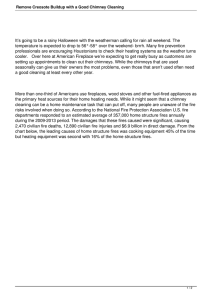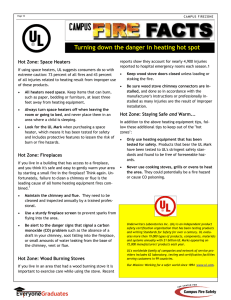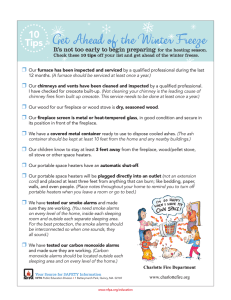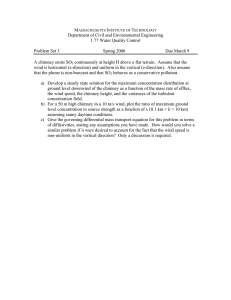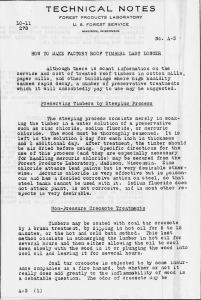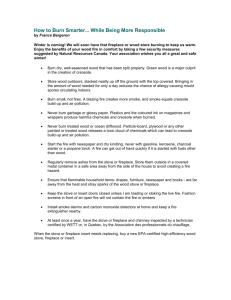Tarring (or Creosote) in a chimney
advertisement
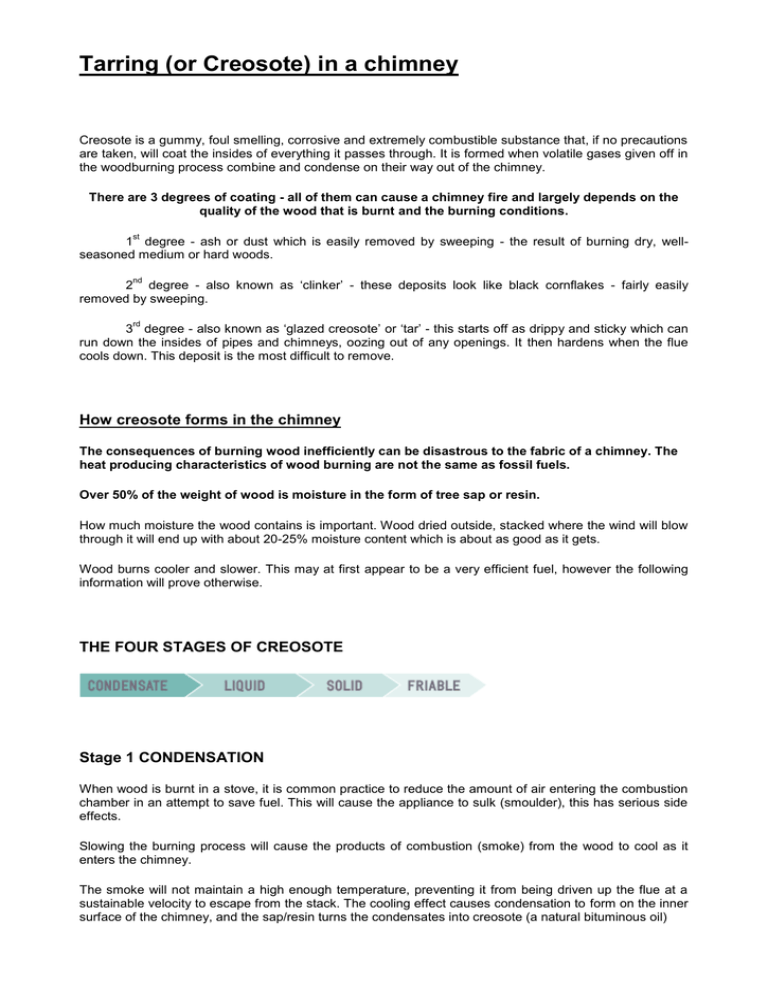
Tarring (or Creosote) in a chimney Creosote is a gummy, foul smelling, corrosive and extremely combustible substance that, if no precautions are taken, will coat the insides of everything it passes through. It is formed when volatile gases given off in the woodburning process combine and condense on their way out of the chimney. There are 3 degrees of coating - all of them can cause a chimney fire and largely depends on the quality of the wood that is burnt and the burning conditions. st 1 degree - ash or dust which is easily removed by sweeping - the result of burning dry, wellseasoned medium or hard woods. nd 2 degree - also known as ‘clinker’ - these deposits look like black cornflakes - fairly easily removed by sweeping. rd 3 degree - also known as ‘glazed creosote’ or ‘tar’ - this starts off as drippy and sticky which can run down the insides of pipes and chimneys, oozing out of any openings. It then hardens when the flue cools down. This deposit is the most difficult to remove. How creosote forms in the chimney The consequences of burning wood inefficiently can be disastrous to the fabric of a chimney. The heat producing characteristics of wood burning are not the same as fossil fuels. Over 50% of the weight of wood is moisture in the form of tree sap or resin. How much moisture the wood contains is important. Wood dried outside, stacked where the wind will blow through it will end up with about 20-25% moisture content which is about as good as it gets. Wood burns cooler and slower. This may at first appear to be a very efficient fuel, however the following information will prove otherwise. THE FOUR STAGES OF CREOSOTE Stage 1 CONDENSATION When wood is burnt in a stove, it is common practice to reduce the amount of air entering the combustion chamber in an attempt to save fuel. This will cause the appliance to sulk (smoulder), this has serious side effects. Slowing the burning process will cause the products of combustion (smoke) from the wood to cool as it enters the chimney. The smoke will not maintain a high enough temperature, preventing it from being driven up the flue at a sustainable velocity to escape from the stack. The cooling effect causes condensation to form on the inner surface of the chimney, and the sap/resin turns the condensates into creosote (a natural bituminous oil) Stage 2 LIQUIFICATION The condensates turn to liquid. The liquid creosote seeps into the mortar joints and the masonry, the corrosive effects of the creosote then destroys the masonry and mortar joints, in the same way as oil destroys concrete garage bases. Stage 3 SOLIDIFICATION Varying temperatures within the chimney cause the liquid creosote to heat up and cool down. As it cools, it solidifies on the internal surfaces of the chimney and the creosote quickly builds up, reducing the cross sectional area of the chimney and in some cases blocking the flue completely. The visual appearance of solidified creosote resembles that of tar and many people refer to it as tar build up. Solid-state creosote is highly flammable and serious chimney fires are a regular occurrence from wood burning. Temperatures exceeding 2000ºC have been recorded from such fires. Stage 4 FRIABLE STATE CREOSOTE When solid-state creosote burns, all the volatile oils are burnt off leaving a residue similar to a honeycomb, which is crisp and easy to sweep from the chimney. However we would never recommend setting fire to a chimney to clean it, this would be a sure way to becoming homeless. The conditions that encourage the build-up of creosote Restricted air supply, unseasoned wood and cooler than normal chimney temperatures are all factors that can accelerate the build-up of creosote on chimney flue walls. Creosote condensation also occurs more rapidly in chimneys on the side of the house rather than in a chimney that runs through the centre. Air supply: The longer the smoke's "residence time" in the flue, the more likely it is that creosote will form. If the air supply of a fireplace is restricted by closed glass doors, or by failure to open the damper wide enough to move heated smoke up the chimney, creosote will build up rapidly. A wood stove's air supply can be limited by closing down the stove damper or air inlets too soon and too much, or by improperly using the stovepipe damper to restrict air movement. Wet firewood: Because it is wet, it creates much less heat, and actually fails to burn up a lot of the available fuel in the wood. Because so much energy is used initially just to drive off the water trapped in the cells of the logs, burning wet wood causes the whole fire, and the flue to stay cool. All the water contained in the wood is turned to saturated steam as the wood burns. It enters the stack as steam and water droplets at a temperature of around 212º F. This is considerably cooler than the condensation point of the creosote gasses, 250º F. Thus, the presence of the steam cools the chimney, the gases condense and creosote is formed. This is true whether you burn hard or soft wood. The moisture content is all that matters. You can’t eliminate it, but burning seasoned wood will keep it to a minimum. Only dry, well seasoned wood should be used in any chimney system. Unseasoned firewood: The "smoke" of unseasoned wood is heavily laden with unburned creosote. Because unseasoned wood causes the whole system to burn cool, the creosote laden flue gas quickly condenses on the surface of the flue. Third stage glazed tar creosote in an open chimney is almost always caused by burning wet, or unseasoned wood. In the case of wood stoves, overloading the firebox with wood in an attempt to get a longer burn time also contributes to creosote build-up. How to restrict the build-up of creosote and reduce the chance of a chimney fire Whatever form it takes, creosote is highly combustible. If it builds up in sufficient quantities and the internal flue temperature is high enough the result could be a chimney fire. Once creosote has formed in the chimney, you can’t eliminate the chance that a chimney fire will occur. There are chemicals available to remove creosote and the most effective are administered by specialists but at significant cost. You can minimise the risk by following a few simple rules: use only dry, well-seasoned medium to hard wood logs. do not burn large quantities of soft wood, painted, treated or tanalised wood. where possible use smokeless coal in conjunction with the wood. do not throw anything onto the fire that can ignite and fly up the chimney, e.g. paper, cardboard, etc, do not allow the fire to get too big where flames can reach the creosote. when using a woodburning stove overnight, open up the stove and burn hard for at least 30 mins each morning to heat the flue up. Periodical ‘hard burning’ throughout the day is also recommended. This will go some way to burn off any creosote that’s tried to form. when using a multi-fuel stove overnight, only burn smokeless coal without logs. IN ALL CASES A CHIMNEY SHOULD BE SWEPT AND INSPECTED AT LEAST ONCE A YEAR The advantages of fitting a steel liner to wood burning stoves Many people are reluctant to spend money fitting a steel liner to a stove because it is not visible and the advantages are not immediately obvious. The following points may change your mind: Firstly - if a woodburning or multi-fuel stove is vented into a masonry chimney, the flue is up to 10 times too large for the inserted stove. The larger the surface area of the flue, the longer it takes to heat up resulting in a higher risk of ‘tarring’. Secondly - the ‘register plate’ fitted to prevent heat generated by the stove from escaping up the chimney has the added effect of keeping the flue cooler than would be the case in an open fire. Both of these facts increases the smokes "residence time" and decreases draw. In such conditions, the flue rapidly builds up creosote because the large air space can not heat up quickly enough. Not only does this cause rapid creosote condensation, it also prohibits the stove from burning efficiently! Simply by relining such a chimney may increase heat out put and efficiency by 200% and will cut creosote condensation down to minimal levels. Because the total volume of air inside a smaller flue is less, it can stay much hotter: this causes a stronger draw and allows the flue gases to escape into the atmosphere before it condensates. A stronger draw also enables the stove to burn hotter.
